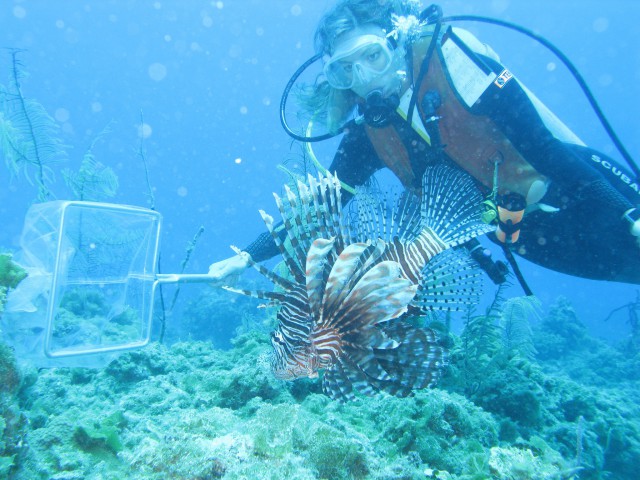
REMOVING LIONFISH ALLOWS FOR SUCCESSFUL RECOVERY OF NATIVE FISH POPULATIONS
The damage the invasive population of lionfish in the Atlantic Ocean is doing to native species can be reduced if lionfish are eliminated in isolated, small areas, according to a new study from Oregon State University, Simon Fraser University, Reef Environment Education Foundation and other institutions.
The 18-month study, released Jan. 22, surveyed 24 natural coral patch reefs in the Bahamas. Native species, prey to lionfish, were wiped out by the aggressive, venomous lionfish with no natural predator by as much as 95 percent, but would rebound if lionfish populations were decreased by 75 percent to 95 percent.
“This is excellent news,” said Stephanie Green, a marine ecologist in the College of Science at Oregon State University, and lead author on the report just published in Ecological Applications. “It shows that by creating safe havens, small pockets of reef where lionfish numbers are kept low, we can help native species recover.
“And we don’t have to catch every lionfish to do it.”
The findings may translate to management strategies for other invasive species around the world.
CU STUDY SHOWS SIZE, ACTIVITY AFFECT MAMMALS’ RESPONSE TO CLIMATE CHANGE
Larger mammals and those active only during the day or only at night are the most affected by climate change, according to a study published Jan. 22 in the journal Global Change Biology.
“Overall the study suggests our large, charismatic fauna animals like foxes, elk, reindeer and bighorn sheep — may be more at risk from climate change,” Christy McCain, assistant professor at the University of Colorado Boulder, said in a press release from the university. According to the data on 73 North American mammal species, body size is the best predictor for a mammal responding negatively to climate change — so an elk is 27 times more likely to respond to climate change than a shrew.
“If we can determine which mammals are responding to climate change and the ones that are at risk of disappearing, then we can tailor conservation efforts more toward those individual species,” said McCain, who led the study.














